Back to the list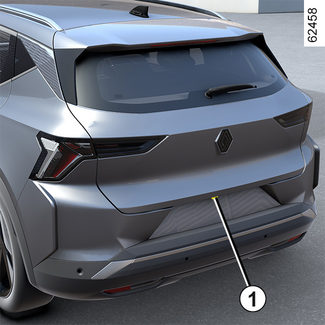
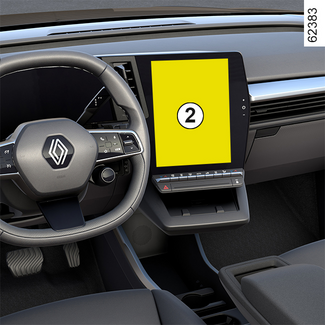


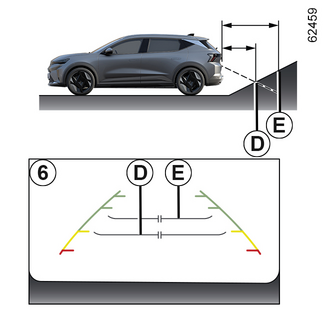
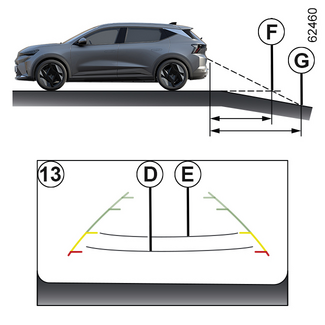
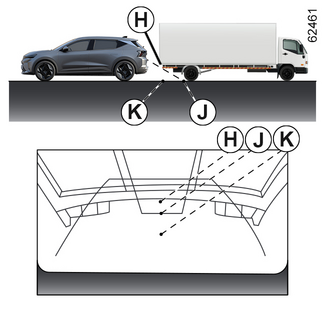
Reversing camera
Reversing camera
Operation

When reverse gear is engaged, the camera 1 located at the rear of the vehicle transmits a view of the area behind the vehicle
to the multimedia display 2 accompanied by three guide lines 3, 4 or 5 (fixed, moving and trailer guide lines).
This system uses several guidelines for its operation (mobile for trajectory and fixed
for distance). When the red zone is reached, use the bumper image to stop accurately.

Fixed guide lines 3
The fixed gauge includes coloured markers A, B and C indicating the distance behind the vehicle:
- A (red) at approximately 30 centimetres from the vehicle;
- B (yellow) at approximately 70 centimetres from the vehicle;
- C (green) at approximately 150 centimetres from the vehicle.
This gauge remains fixed and indicates the vehicle trajectory if the wheels are in
line with the vehicle.
Moving guide lines 4
This is shown in blue on the multimedia screen 2. It indicates the vehicle trajectory according to the position of the steering wheel.

Trailer guide lines 5
This is shown in blue on the multimedia screen 2. This indicates the trajectory of the trailer towbar according to the steering wheel
position. It allows the driver to position the towbar as close as possible to the
trailer's towing head.
« Trailer view »
If a trailer is connected, while in a forward gear press the "Camera" menu in the "Vehicle" world on your multimedia screen 2 to enable the camera 1 to transmit a view of the rear environment during approximately 30 seconds.
Settings

From the multimedia screen 2, when reverse gear is engaged, press the "Settings" button to add or remove guide lines and to adjust the camera image settings (brightness,
contrast, etc.).
Please refer to the multimedia instructions for further information.
Tip
Make sure that the camera is not obscured (by dirt, mud, snow, condensation etc.).
"Zoom auto" function
If an obstacle is detected behind the vehicle, the function "Zoom auto" switches the current display to a top rear view.
To activate/deactivate the "Zoom auto" function, refer to the multimedia instructions.
Tip
The screen shows a reverse mirror image.
The frames are a representation projected on a flat surface. This information is to
not be taken into account when superimposed on a vertical object or an object on the
ground.
Objects which appear on the edge of the screen may be deformed.
In very bright light (snow, vehicle in sunshine, etc.), the camera vision may be adversely
affected.
If the luggage compartment is open or incorrectly closed, the "WARNING: Boot Open" message appears.
Operating faults
When reverse gear is engaged, if the system detects an operating fault, a black screen
is displayed temporarily on the multimedia screen 2.
This may be caused by a fault affecting the camera or screen (clearness, fixed image,
delayed communication etc.).
If the temporary display of the black screen persists, please consult an approved
dealer.
WARNING
This function is an additional aid. It cannot, therefore, under any circumstances
replace the vigilance or the responsibility of the driver.
The driver should always be ready for sudden incidents while driving: always ensure
that there are no small, narrow moving obstacles (such as a child, animal, pushchair,
bicycle, stone, post, etc.) in the blind spot when manoeuvring.
Difference between the estimated distance and actual distance

Reversing towards a steep uphill slope
The fixed guidelines 6 show the distances as closer than they actually are.
The objects shown on the screen are actually further away on the slope.
For example, if the screen displays an object at D, the actual distance of the object is at E.

Reversing towards a steep downhill slope
The fixed guidelines 6 show the distances as further than they actually are.
Therefore, the objects shown on the screen are actually closer on the slope.
For example, if the screen displays an object at G, the actual distance of the object is at F.

Reversing towards a protruding object
Position H seems further than position J on the screen. However, position H is at the same distance as position K.
The trajectory indicated by the fixed and mobile guidelines do not take into account
the height of the object. So there is a risk that the vehicle may collide with the
object when reversing towards position K.
